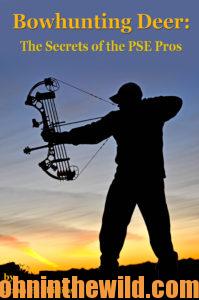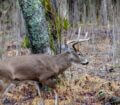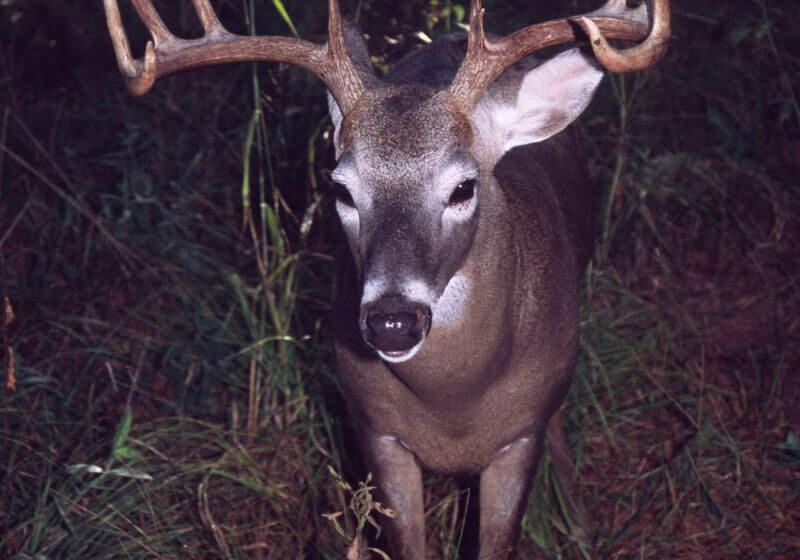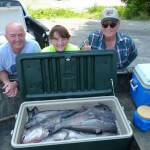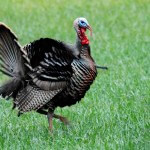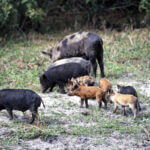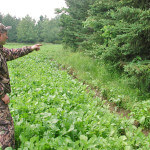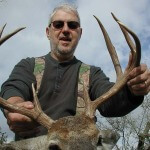Editor’s Note: Today outdoorsmen have begun to learn more about the white-tailed deer. In the past, we haven’t known the right questions to ask. But scientists and researchers have started studying deer more intensely.
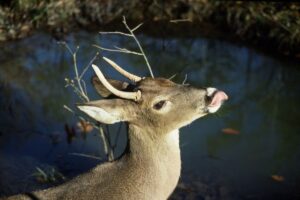 A bull elk will round-up a whole herd of cows and have perhaps 10 cows in his harem. When each of these cows comes into heat, the bull elk will breed her and then eventually all 10. So, in an elk herd, a single dominant bull will have a much-greater impact on the genetics of the herd than a dominant whitetail will. Wildlife biologist, Brian Murphy, reports that what scientists have learned about the way deer breed means good news and bad news. A hunter can’t detrimentally impact a deer herd, since so many different bucks contribute to that genetic gene pool. Even if someone bags the wrong buck, or there’s an over-harvest of bucks, still so-many bucks will contribute to the gene pool that a herd won’t have a great number of inferior bucks. But people who dream of manipulating the genetics of a deer herd by harvesting poorly-antlered bucks more than likely can’t impact a herd, especially one on small acreages. “Shooting cull bucks has no statistical chance of making a difference in the quality of your deer herd,” Murphy emphasizes. “Whether you should or shouldn’t harvest cull bucks is debatable. That cull buck is taking up space and eating groceries and will breed, so I guess you still should take it. But don’t believe that you’re changing the genetic structure of your deer herd dramatically if you harvest cull, white-tailed bucks. Many times, malformed antlers have nothing at all to do with genetics.”
A bull elk will round-up a whole herd of cows and have perhaps 10 cows in his harem. When each of these cows comes into heat, the bull elk will breed her and then eventually all 10. So, in an elk herd, a single dominant bull will have a much-greater impact on the genetics of the herd than a dominant whitetail will. Wildlife biologist, Brian Murphy, reports that what scientists have learned about the way deer breed means good news and bad news. A hunter can’t detrimentally impact a deer herd, since so many different bucks contribute to that genetic gene pool. Even if someone bags the wrong buck, or there’s an over-harvest of bucks, still so-many bucks will contribute to the gene pool that a herd won’t have a great number of inferior bucks. But people who dream of manipulating the genetics of a deer herd by harvesting poorly-antlered bucks more than likely can’t impact a herd, especially one on small acreages. “Shooting cull bucks has no statistical chance of making a difference in the quality of your deer herd,” Murphy emphasizes. “Whether you should or shouldn’t harvest cull bucks is debatable. That cull buck is taking up space and eating groceries and will breed, so I guess you still should take it. But don’t believe that you’re changing the genetic structure of your deer herd dramatically if you harvest cull, white-tailed bucks. Many times, malformed antlers have nothing at all to do with genetics.”
A Texas Study’s Surprising Results from Culling Inferior Buck Deer:
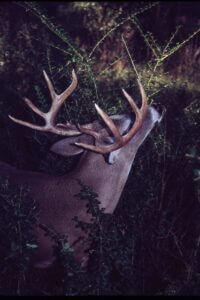
A study was conducted by Dr. Mickey Hellickson, a wildlife biologist, on the 10,000-acre King Ranch in Texas, over a 6-year period, using hunters on the ground and shooters from helicopters. This study removed every cull buck found on those 10,000 acres. After 6 years of absolutely removing every low-quality buck that could be located, the average-age-class buck on the study area was actually smaller than the bucks in the surrounding control areas. They found at the King Ranch that the hunters had zero effect and probably had had a negative effect when they intensively harvested what they would consider cull bucks. This culling program on 10,000 acres was much-more intense than any hunting club ever could duplicate. There were no positive effects that could be shown on a deer herd in the wild by culling inferior bucks.
Spike Bucks Are Inferior – True or False:
Through the years, biologists and hunters have quoted two studies with different outcomes as the gospel concerning spike bucks, one done on the Carr Wildlife Management Area in Texas and the other conducted by Harry Jacobson at Mississippi State University (MSU). The Texas study reports on the inferiority of spike bucks and proves that 1-1/2 year-old spike bucks don’t produce as many antlers or antlers as large at maturity as branched-antler bucks at 1-1/2 years old do. However, the Jacobson MSU study proves that, at least in the Southeast, late birth and poor nutrition can cause small antlers in 1-1/2 year-old bucks that aren’t genetically inferior. 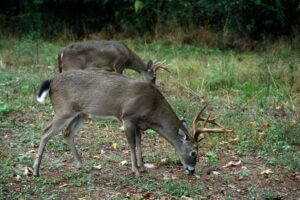 Spike bucks can catch-up to the branch-antlered bucks with more age and better food, and often have larger sizes than the bucks that are branch-antlered at 1- to 1-1/2 years old.
Spike bucks can catch-up to the branch-antlered bucks with more age and better food, and often have larger sizes than the bucks that are branch-antlered at 1- to 1-1/2 years old.
A more-recent study by Dr. Mickey Hellickson at the King Ranch, which has the largest sample size in the world of wild bucks with monitoring from yearling to 5- and 6-year-old deer, has shown that bucks that start with 3 points at 1-1/2 years of age have statistically-smaller sizes than the bucks with 4 points or more at 1-1/2 years old by the time they reach 5- and 6-years old. The 3-point-and-less 1-1/2 year-old bucks score about 20 inches smaller on Boone & Crockett at 5- and 6-years old than the bucks with 4 points or more at 1-1/2 years old do at ages 5 or 6 years.
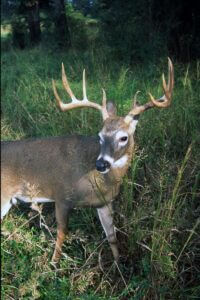
In Hellickson’s Texas study, he managed all these bucks under a quality-deer-management program or a trophy-deer program and fed all the deer supplementally with highly-nutritional food. The size of the deer herd was kept under high restrictions, so that there was no reason for a deer to have less than 3 points at 1-1/2 years old or older. But if you compare this statistic to the late rut in Alabama when does have fawns in August or September, you certainly can see why a buck can’t have 4 to 6 points by hunting season. Scientists believe spikes serve as more of an indication of age and nutrition rather than a sign of inferior genetics.
Deer Herds Are Impacted by Several Factors:
No blanket answer like one shoe fits all explains deer herds. The availability of food, the health of the herd, the size of the herd and many other factors, besides strictly genetics, play roles in antler development. The more we learn about deer, the more we realize that we can best manage deer on a property-by-property basis, since researchers have found very-few absolutes. Never set up a deer-management program based on what other people have done in other regions. Instead, determine the best type of deer-management program for the hunters in your club, the deer on your property, the soil types, the vegetation and the terrain you hunt.
John E. Phillips’ latest deer book “How to Hunt Deer Like a Pro: Volume II,” just was published on Amazon in print at https://www.amazon.com/gp/product/B0BGSP3QPB/ref=dbs_a_def_rwt_hsch_vapi_tpbk_p4_i4
The Audible version should be available by December. Since deer hunting and deer hunters are drastically changing each year, John interviewed some top deer hunters like Mark Drury, Dr. Larry Marchinton, Dr. Bob Sheppard, Pat Reeve, Gene Wensel, Cody Robbins, Ernie Calandrelli, Brian Murphy and Luke Brewster, who took the world’s largest whitetail, to learn their up-to-date techniques for successfully hunting deer and having more places to hunt. Also, John’s first book in that series “How to Hunt Deer Like a Pro” in Kindle, print and Audible at https://www.amazon.com/dp/B007D3H08M includes other outstanding deer hunters. Too, check-out John’s book, “Bowhunting Deer: the Secrets of the PSE Pros,” https://www.amazon.com/gp/product/B0091T1NKM/ref=dbs_a_def_rwt_hsch_vapi_taft_p1_i1, available now in Kindle, print and Audible versions. 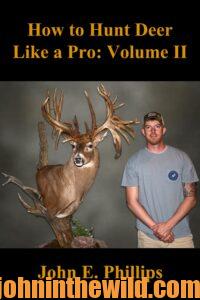 You may have to copy and paste these links into your browser.
You may have to copy and paste these links into your browser. 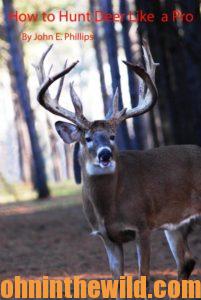 When you click on these books, notice on the left where Amazon says you can read and hear 10% of the Audible books for free. On the right side of the pages and below the offer for a free Audible trial, you can click on Buy the Audible book.
When you click on these books, notice on the left where Amazon says you can read and hear 10% of the Audible books for free. On the right side of the pages and below the offer for a free Audible trial, you can click on Buy the Audible book.
Tomorrow: Photograph Deer and Develop a Hit List 